Meldingen din er sendt.
Vi behandler forespørselen din og kontakter deg så snart som mulig.
Skjemaet har blitt sendt inn.
Mer informasjon finner du i postkassen din.



La oss begynne med å knuse den største myten innen teknologi i dag.
Du har sikkert hørt det hundre ganger: "Alle moderne virksomheter trenger en mobilapp." Høres overbevisende ut, ikke sant? Vi er jo alle klistret til mobilen. Apper føles som det logiske neste steget for en bedrift som ønsker å utvide rekkevidden sin. Men her er sannheten de fleste utviklingsbyråer ikke vil fortelle deg: Ikke alle bedrifter trenger en app - og i noen tilfeller kan det å bygge en app faktisk bremse deg.
Ja, jeg sa det.
For her er saken: Å bygge en mobilapp er en stor forpliktelse. Det handler ikke bare om å lansere noe kult - det handler om å løse et reelt problem på en måte som er verdt investeringen. Og hvis den verdien ikke er der? Kanskje du heller bør bruke energien på noe annet - for eksempel på å optimalisere mobilnettstedet ditt eller utforske en progressiv webapp (PWA) i stedet.
Denne artikkelen tar deg gjennom begge sider. Vi ser på de virkelige fordelene med mobilapper for bedrifter - økt engasjement, bedre lojalitet, tilgang til innfødte funksjoner - og de mindre glamorøse ulempene, som høye utviklingskostnader og vedlikeholdsproblemer.
Jeg deler til og med et enkelt jukseark som hjelper deg med å finne ut om en mobilapp er det rette tiltaket for bedriften din.
Og hvis det er det? Flott - det er der Innowise kan hjelpe. Vi er ikke bare en gjeng med programmerere som bygger det du ber om. Vi er en strategisk teknologipartner som stiller de vanskelige spørsmålene, utfordrer antakelser og hjelper deg med å skape noe som faktisk beveger nålen. Enten du trenger fullskala tjenester for utvikling av mobilapper eller bare vil ha en annen mening...
Så la oss komme i gang.
Når er en mobilapp et smart forretningstrekk - og når er den bare nok en skinnende distraksjon?
La meg si dette på forhånd: Jeg er ikke anti-app. I bygge apper som levebrød. Men de beste appene - de som gir virkelig avkastning på investeringen - er laget av de rette grunnene. Ikke fordi "alle andre gjør det", men fordi de tjener et spesifikt formål som ingen nettside eller webapp kan matche.
Her er scenariene der det ikke bare er smart å bygge en mobilapp - det er en strategisk no-brainer. Fordelene med en mobilapp for bedrifter er åpenbare når du forstår den unike verdien den gir, men det er ikke alle bedrifter som trenger en app for å blomstre.
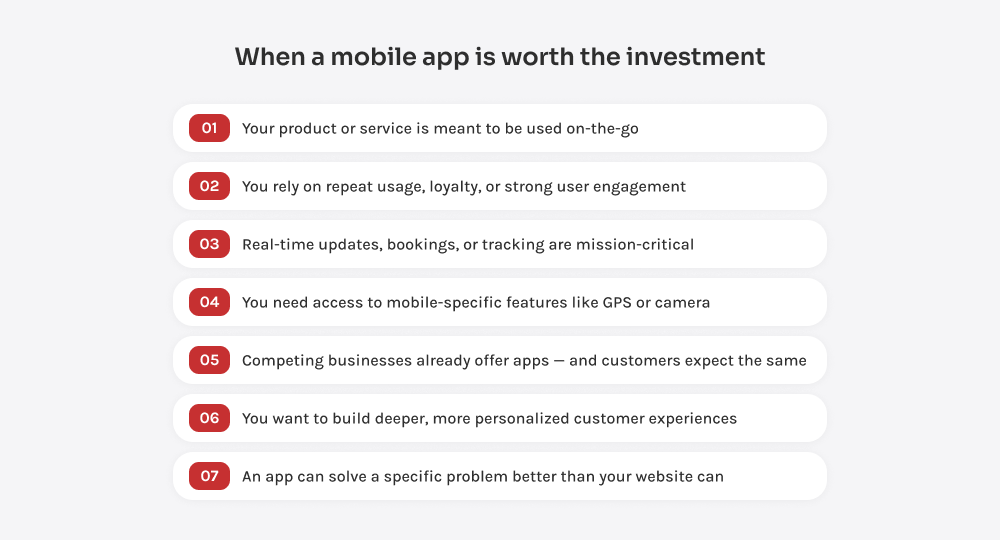
Hvis produktet ditt er mobilt av natur - tenk på fintech-plattformer, strømmetjenester, verktøy for sosiale medier eller e-læring - er en app ikke valgfritt. Det er fundamentet.
Prøv å se for deg Spotify eller Duolingo som rene nettleserplattformer. Ikke så spennende, ikke sant?
Apper på dette området er ikke bare praktiske. De er forventet. Mobilapper for slike virksomheter er produktet, ikke en sidefunksjon. Fra bankapper til meditasjonsabonnementer - hvis brukerne samhandler med tjenesten din regelmessig og på farten, vil de ha hastigheten, tilgjengeligheten og finpussingen til en egenutviklet app.
Vil du ha bevis? Se på en hvilken som helst seriøs fintech-oppstartsbedrift. Utvikling av bankapper er trinn null for å holde på kundene.
Noen apper ligger ikke bare på brukerens telefon - de bli en vane.
Hvis modellen din er avhengig av å holde på kundene og hyppig interaksjon, kan en mobilapp bli ditt hemmelige våpen. Jeg snakker om push-varsler, personaliserte tilbud, lojalitetsprogrammer, utsjekking med ett klikk... alt.
Tenk Starbucks. Tenk Zara. Tenk MyFitnessPal.
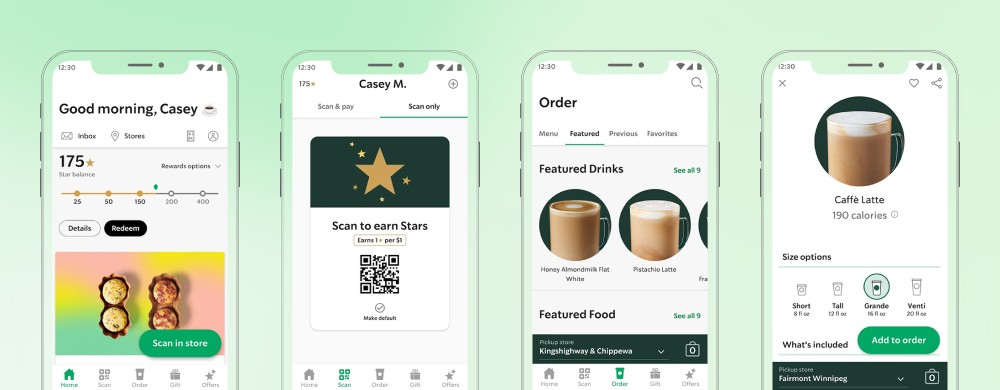
Disse appene leverer ikke bare nytteverdi - de bygger rutiner. Og fordelene med en app i denne kategorien er enorme: høyere livstidsverdi, bedre oppbevaring og flere gjentatte kjøp.
Nettsteder kan ikke konkurrere på dette nivået av intimitet.
Det er her det begynner å haste.
Hvis virksomheten din er avhengig av bestillinger, oppdateringer eller sporing i sanntid, holder det ikke med et webgrensesnitt. Kundene ønsker ikke å logge seg inn på en mobil nettleser når budet er tre minutter unna eller avtalen nettopp har blitt utsatt.
Det er derfor plattformer som Uber, DoorDash og de fleste apper for levering og logistikk trives i mobil-først-miljøer. Behovet for sanntidsfunksjonalitet er for stort. En mobilapp forbedrer ikke bare opplevelsen - den det gjør opplevelsen mulig.
Hvis du bygger for sanntidsinteraksjon - som direktebestillinger, sporing av bud eller noe annet tidssensitivt - finnes det egentlig ingen erstatning for en mobilapp. Forsinkelsen og begrensningene i mobilnettlesere er ikke nok når brukerne trenger umiddelbar tilbakemelding. Jeg har sett bedrifter prøve å få det til å fungere med nettapper, og det ender nesten alltid med frustrasjon hos brukerne. Med native-apper får du hastigheten, push-varslene og den tette enhetsintegrasjonen som sanntidsbruken krever. Det handler ikke bare om brukeropplevelse - det handler om å levere pålitelighet under press.
Nå begynner vi å komme inn på det tekniske. Men denne delen er viktig.
Hvis tjenesten din er avhengig av smarttelefonspesifikke funksjoner - GPS, kameratilgang, AR-funksjoner, gyroskop, offline-funksjonalitet - er en egen mobilapp fortsatt det beste alternativet inntil videre.
Ja, det er sant at progressive webapper (PWA-er) og moderne webteknologi kan få tilgang til maskinvarefunksjoner som kameraet eller til og med levere AR gjennom WebXR. Men her er haken: Nettleserbasert AR støter ofte på kompatibilitetsproblemer, ytelsesbegrensninger eller krever mer innsats for å skape en sømløs opplevelse på tvers av enheter.
Det er grunnen til at merkevarer som IKEA - som tilbyr oppslukende AR-forhåndsvisninger i sanntid i kundenes hjem - vanligvis velger native. Når presisjon, respons og dyp maskinvareintegrasjon er viktig, har native-apper fortsatt fortrinn. Her er fordelene med mobilapper for bedrifter forankret i evneikke bare bekvemmelighet.
La oss snakke om markedspresset.
Noen ganger handler ikke avgjørelsen bare om hva virksomheten din trenger. Det handler om hva din kunder forvent det. Hvis du er den eneste banken, treningssenteret eller lojalitetsdrevne nettbutikken i ditt område som ikke har en mobilapp, er du ikke minimalistisk - du er forglemmelig.
En elegant, funksjonell app kan være en differensiator. Men i noen bransjer er det bare en grunnlinje. Hvis du ikke har en slik app, ser du ut som om du ikke er oppdatert.
Med andre ord: hvis alle i din nisje gjør det bra, det må du på en måte også.
La meg gi deg et eksempel fra vår egen erfaring - ikke noe fluff, bare fakta.
A restaurantkjede fra Europa kom til oss for å få innpass i det blomstrende markedet for matlevering. De hadde allerede en solid base av lojale kunder, men de visste at de måtte fornye seg for å holde seg konkurransedyktige og vokse. Målet var enkelt: å lage en fullt integrert, tilpassbar mobilapp for matlevering, et elegant nettsted for bestillinger og reservasjoner, og et lojalitetssystem som ville få kundene til å komme tilbake for mer.
Så vi begynte å jobbe.
Vi utviklet en mobilapp med to nøkkelroller: kunder som bestiller mat, og bud som leverer den. Vi integrerte sporing av bestillinger i sanntid, push-varsler, flere betalingsalternativer og til og med en AI-drevet stemmeassistent for å hjelpe budene med å navigere i trafikken og holde tidsplanen. Appen var ikke bare et verktøy; den var en "game-changer" når det gjaldt å forbedre leveringshastigheten, redusere drivstoffutgiftene og bygge tillit hos kundene. Dette er noen av de viktigste fordelene med mobilapper for bedrifter: effektivisering, bedre kundeinteraksjon og økt lojalitet.

På nettsidene sørget vi for at kundene enkelt kunne bla gjennom menyen, reservere bord og legge inn bestillinger for henting eller levering - samtidig som vi sørget for en sømløs, visuelt tiltalende opplevelse. Og vi ga oss ikke med det: Vi integrerte et lojalitetskortsystem som ga incentiver til gjentatte besøk, med bonuspoeng og belønninger for stamkunder.
Hva ble resultatet?
Dette handlet ikke bare om å bygge en skinnende app. Det handler om å forstå kundens behov, tilføre verdi ved hvert berøringspunkt og kontinuerlig iterere på løsningen for å skape reell effekt.
Det er styrken ved å bygge rett appen på rett tid - støttet av strategi, ikke bare kode.
La oss gjøre det klart: Mobilapper er fantastisk... men de er ikke løsningen for alle virksomheter. Det finnes faktisk mange scenarier der det ikke bare er unødvendig å investere i en app - det er rett og slett ineffektivt.
Selv om det er klare fordeler med å ha en mobilapp for bedriften din, er det ikke alle bedrifter som trenger eller har nytte av en.
Så hvordan kan du vite når en app kan være mer til hinder enn til hjelp? Her er tegnene du bør se etter.
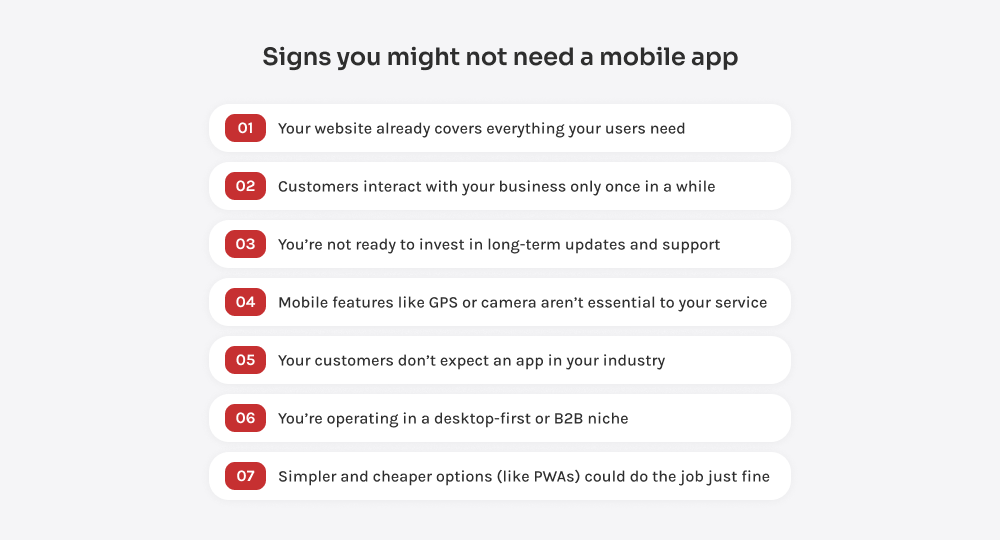
La oss være ærlige - det er ingen vits i å satse på en app hvis nettstedet ditt allerede gir brukerne den opplevelsen de trenger. Jeg snakker om virksomheter som ikke er avhengige av høyt engasjement, oppdateringer i sanntid eller eksklusive mobilfunksjoner.
Hvis nettstedet ditt tilbyr alt brukerne trenger - enten det er å surfe på bloggen din, legge inn en bestilling eller få serviceinformasjon - kan et godt optimalisert nettsted tjene samme formål. I tillegg er den enklere å vedlikeholde, billigere å bygge og når ut til et bredere publikum (fordi den er tilgjengelig på alle enheter).
Ta for eksempel en liten bedrift med en blogg eller en enkel nettbutikk. En app for noe så grunnleggende som å bla gjennom artikler eller gjøre engangskjøp gir ikke nok verdi til å rettferdiggjøre investeringen. Brukerne dine får sannsynligvis tilgang til den via telefonens nettleser.
Dette er et viktig spørsmål. Samhandler brukerne dine med plattformen din en gang i blant, og det er det hele?
Hvis kundene bare besøker nettstedet ditt av og til - kanskje for engangskjøp, bestillinger eller generelle forespørsler - vil de ikke laste ned en app for å bruke den i noen få minutter. Statistikken underbygger dette. Noen apper blir forlatt etter en eller to bruksområder. Hvis virksomheten din ikke oppmuntrer til daglig eller hyppig interaksjon, er det lite som motiverer brukerne til å beholde appen din på telefonen.
Tenk på det: Du ville ikke installert en app bare for å sjekke åpningstidene til en restaurant. Den samme logikken gjelder hvis virksomheten din er mer "sett det og glem det" enn en løpende tjeneste.
Å bygge en app er bare begynnelsen. Og det er her mange bedrifter overser de reelle kostnadene ved å design av mobilapper og utvikling.
Du trenger ressurser til løpende vedlikehold: feilrettinger, sikkerhetsoppdateringer, funksjonsjusteringer og kompatibilitetsjusteringer med de nyeste OS-versjonene. Hvis du ikke har budsjett eller arbeidskraft til å vedlikeholde appen etter at den er lansert, kan du risikere å få en app som blir foreldet eller utgjør en sikkerhetsrisiko over tid.
Jeg har jobbet med mange bedrifter som ivrig lanserer en app, men som ikke klarer å holde den oppdatert. De tror at de bare kan bygge den, og at appen vil kjøre seg selv. Tro meg, det fungerer ikke slik.
Hvis du ikke har et dedikert team eller et solid budsjett for langsiktig støtte, er det bedre å vente.
Det er ikke alle bransjer som trives med mobilapper. Hvis virksomheten din opererer i en nisje der apper ikke er det primære kontaktpunktet for kundene - for eksempel industrielle B2B-tjenester eller spesialisert bedriftsprogramvare - er det ingen grunn til å presse på for en app. Målgruppen din er sannsynligvis fornøyd med å få tilgang til tjenestene dine på en datamaskin eller via et nettgrensesnitt.
Ta en produksjonsbedrift eller et programvareselskap som tilbyr nisjetjenester innen B2B. Dette er ikke den typen virksomheter som vil se kundene sine gripe etter mobilen for å bruke tjenesten. I slike tilfeller er det ikke bare unødvendig å bygge en app - det er også sløsing med ressurser.
La oss være realistiske et øyeblikk.
Du har sikkert sett de glitrende brosjyrene og den glansete argumentasjonen om hvordan apper vil øke inntektene dine, skyte brukerengasjementet i været og endre spillereglene for bedriften din. Men det er noe de ikke alltid forteller deg: Det er ikke billig å bygge og vedlikeholde en mobilapp - og det er ikke noe man bare gjør én gang.
Det er faktisk mange skjulte kostnader som mange bedrifter ikke er klar over før de allerede er langt inne i prosjektet.
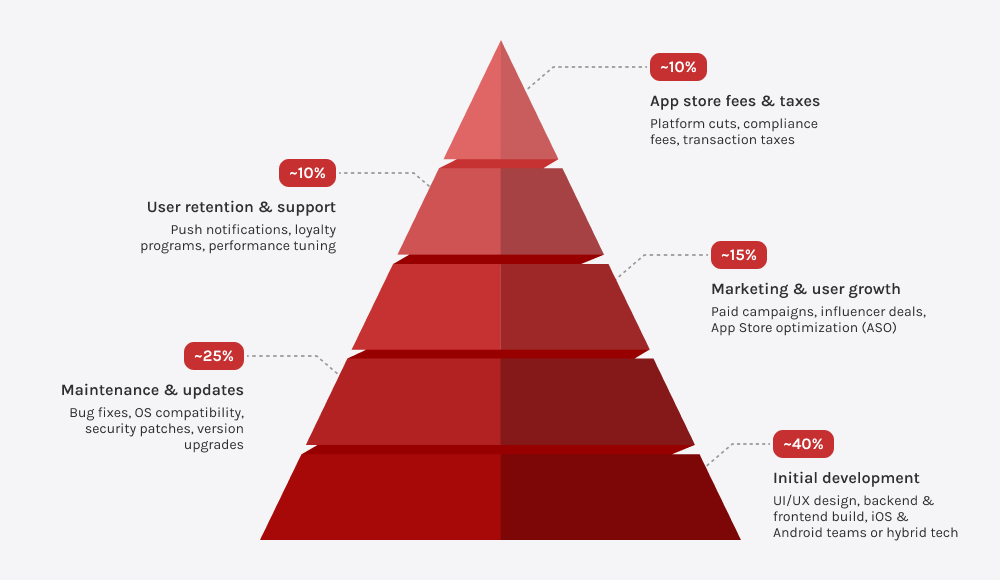
Det er lett å tenke på en app som et enkelt produkt som enten er "ferdig" eller "ikke ferdig". Men i virkeligheten er utviklingsfase er bare begynnelsen.
Hvis du bygger en native app (dvs. en app for iOS eller Android), må du regne med separate utviklingskostnader for hver plattform. Det er fordi en app som er spesialutviklet for iOS, trenger annen koding og testing enn en app som er utviklet for Android. Du kan gå for en hybrid-app for å spare noen kroner, men selv da kan ytelsen og brukeropplevelsen bli dårligere (det er her vår ekspertise innen Android og Utvikling av iOS-apper kommer inn i bildet).
Du må også ta hensyn til Teknologibunke - og dette kan bli dyrt. Jo mer kompleks appen er, desto høyere blir utviklingskostnadene. Funksjoner som sanntidsoppdateringer, AI-integrasjoner eller GPS-sporing øker kompleksiteten (og kostnadene).
Det er her budsjettet kan komme ut av proporsjoner.
Når appen din er lansert, blir den ikke bare liggende der. Du må ta hensyn til løpende vedlikeholdskostnader - feilrettinger, OS-oppdateringer, sikkerhetsoppdateringer og sikring av kompatibilitet med de nyeste enhetene og operativsystemene.
På toppen av dette kommer eventuelle forespørsler om nye funksjoner eller ytelsesoppgraderinger til en ekstra kostnad. Budsjettet bør derfor ikke bare inkludere byggekostnaden - du bør planlegge et eget budsjett for å holde appen i gang på lang sikt.
Hvis du ikke planlegger for dette, kan du ende opp med en utdatert, treg eller til og med usikker app som er mer bry enn den er verdt.
Så du har brukt alle disse pengene på å bygge appen din. Hvordan får du folk til å faktisk bruk den?
Dessverre betyr ikke lanseringen av appen din automatisk at brukerne laster den ned. Med over 4 millioner apper på iOS og Android, er det å skille seg ut fra mengden vanskelig. App Store-optimalisering (ASO), markedsføringskampanjer, influencer-partnerskap - alt dette koster penger hvis du vil at appen din skal bli lagt merke til.
Selv etter at appen din er lastet ned, brukeroppbevaring blir den neste utfordringen. En stor andel av brukerne forlater apper etter én eller to gangers bruk. Uten en solid markedsføringsstrategi for å holde folk engasjert - gjennom push-varsler, kampanjer i appen eller lojalitetsprogrammer - kan appen din bli glemt like fort som den ble lastet ned.
Og akkurat når du trodde du var ferdig, la oss snakke om App Store-avgifter.
For både Google Play Store og Apple App Store er plattformen kan ta et 30%-kutt av inntektene fra appen din. Det betyr at hvis du tar $10 for et abonnement, tar appbutikken $3. Det er en ganske stor del av fortjenesten din. Og hvis du planlegger å tilby betalte apper eller kjøp i appen, må denne kostnaden tas med i prisstrategien din.
Så du har bestemt deg for at en mobilapp er fremtiden din. Men her er det neste spørsmålet: Skal du bygge en native app (iOS eller Android), en webapp (PWA) eller en hybridapp?
Hver av dem har sine egne fordeler, avhengig av bedriftens behov, og fordelene med mobilapper for små bedrifter og bedrifter varierer ut fra faktorer som ytelse, funksjonalitet og kostnadseffektivitet. For eksempel krever utvikling av bankapper høy sikkerhet og sanntidsfunksjonalitet, noe som gjør native-apper til det beste valget. På samme måte, utvikling av mobilspill krever høy ytelse, jevn grafikk og lav ventetid. Alt dette gjør native-apper ideelle for å levere den beste spillopplevelsen.
Hvert alternativ har sine fordeler og ulemper, avhengig av bedriftens behov, budsjett og langsiktige mål. La oss dele det opp.
| Funksjon | Innfødt app | Nettapp (PWA) | Hybrid-app |
|---|---|---|---|
| Ytelse | Høyt | Moderat | Moderat |
| Frakoblet tilgang | Ja | Begrenset | Begrenset |
| Enhetens funksjoner | Full tilgang (kamera, GPS) | Begrenset | Delvis tilgang |
| Brukeropplevelse | Det beste | Bra, men begrenset | Bra, men ikke like opprinnelig |
| Tilstedeværelse i appbutikken | Ja | Nei | Ja |
| Utviklingstid | Lang | Kort | Moderat |
| Utviklingskostnader | Høyt | Lav | Moderat |
Når det kommer til stykket, er det en stor beslutning å avgjøre om bedriften din trenger en app. Det handler ikke bare om å hoppe på mobiltrenden; det handler om å sikre at investeringen i apputvikling er fornuftig med tanke på forretningsmodellen, kundebehovene og de langsiktige målene dine. For å hjelpe deg med å ta den avgjørelsen har jeg satt sammen et rammeverk for raske beslutninger - en rekke spørsmål du kan stille deg selv for å vurdere om en mobilapp virkelig er nødvendig.
Hvis virksomheten din er avhengig av umiddelbar kommunikasjon eller kontinuerlige oppdateringer - for eksempel meldinger, sporing i sanntid eller booking - kan en app være avgjørende. Hvis kundene samhandler regelmessig med plattformen din og trenger umiddelbar tilgang, kan en mobilapp være den rette løsningen.
Krever tjenesten din unike smarttelefonfunksjoner som en webapp ikke har full støtte for, for eksempel GPS-navigasjon, kamerafunksjonalitet eller offline-tilgang? I så fall kan en egenutviklet app være et bedre valg, ettersom den kan tilby sømløs integrasjon med disse funksjonene.
Å bygge en app er bare begynnelsen. Vedlikehold, feilrettinger og oppdateringer er en løpende kostnad - og de er nødvendige for at appen skal fungere problemfritt. Hvis du ikke har ressurser til langsiktig support, er det ikke sikkert at en app er det rette valget for deg.
Se på konkurrentene dine: Har de allerede mobilapper? Hvis apper er i ferd med å bli standard i din bransje og konkurrentene dine høster fordelene, kan det være en ulempe for deg å ikke ha en. Hvis en app kan hjelpe deg med å skille deg ut, er det verdt å vurdere.
Noen ganger kan et responsivt nettsted eller en progressiv webapp (PWA) levere den samme funksjonaliteten uten de ekstra kostnadene ved å utvikle og vedlikeholde en egenutviklet app. Hvis du kan tilby de samme funksjonene via en nettplattform, hvorfor da komplisere ting med en app?
Her er en kjapp jukseoversikt slik at du kan ta et mer informert valg.
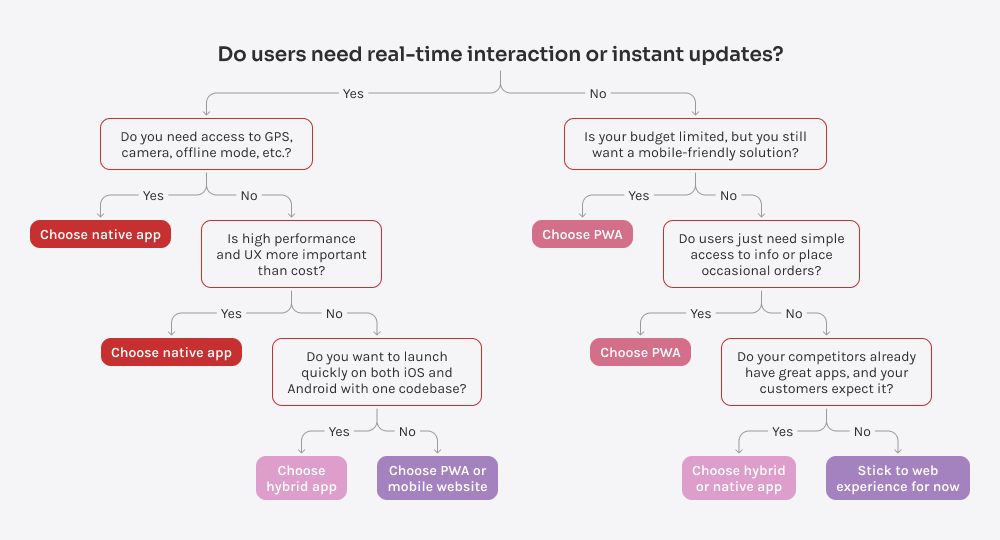
Så her er greia: Å lage en app er ikke en løsning som passer for alle. Det handler om å sørge for at den passer bedriften din som hånd i hanske, ikke bare fordi det er en kul ting å gjøre. Hvis appen din kan skape reell verdi, løse spesifikke problemer og drive virksomheten din fremover, er den absolutt verdt investeringen. Men hvis det ikke er det rette trekket? Ikke tving det frem - det finnes andre måter å nå målene dine på uten ekstra kostnader og kompleksitet.
Hvis du lurer på "Hvordan kan en mobilapp hjelpe virksomheten min?", så la oss snakke om de unike måtene den kan skape verdi for deg på.
Hos Innowise handler det ikke bare om å hoppe på de nyeste trendene. Vi fokuserer på å gi deg de riktige løsningene gjennom våre velprøvde tilnærming til apputvikling. La oss ta en samtale om hva som er fornuftig for din virksomhet, og hvordan vi kan bygge en løsning som faktisk hjelper deg med å vokse.

Leder for mobil
Eugene driver vår mobilvisjon med et skarpt blikk på ytelse, brukervennlighet og fremtidssikker teknologi. Han hjelper bedrifter med å gjøre store ideer om til raske, intuitive apper som folk faktisk ønsker å bruke.

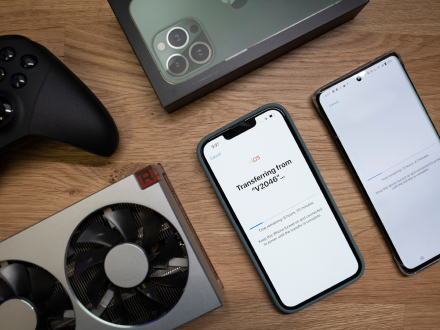

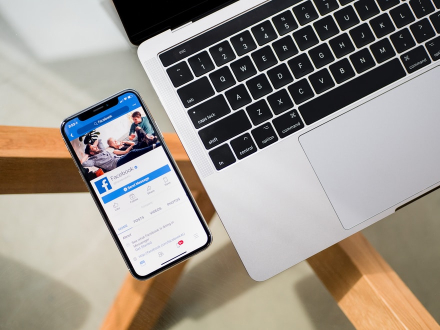







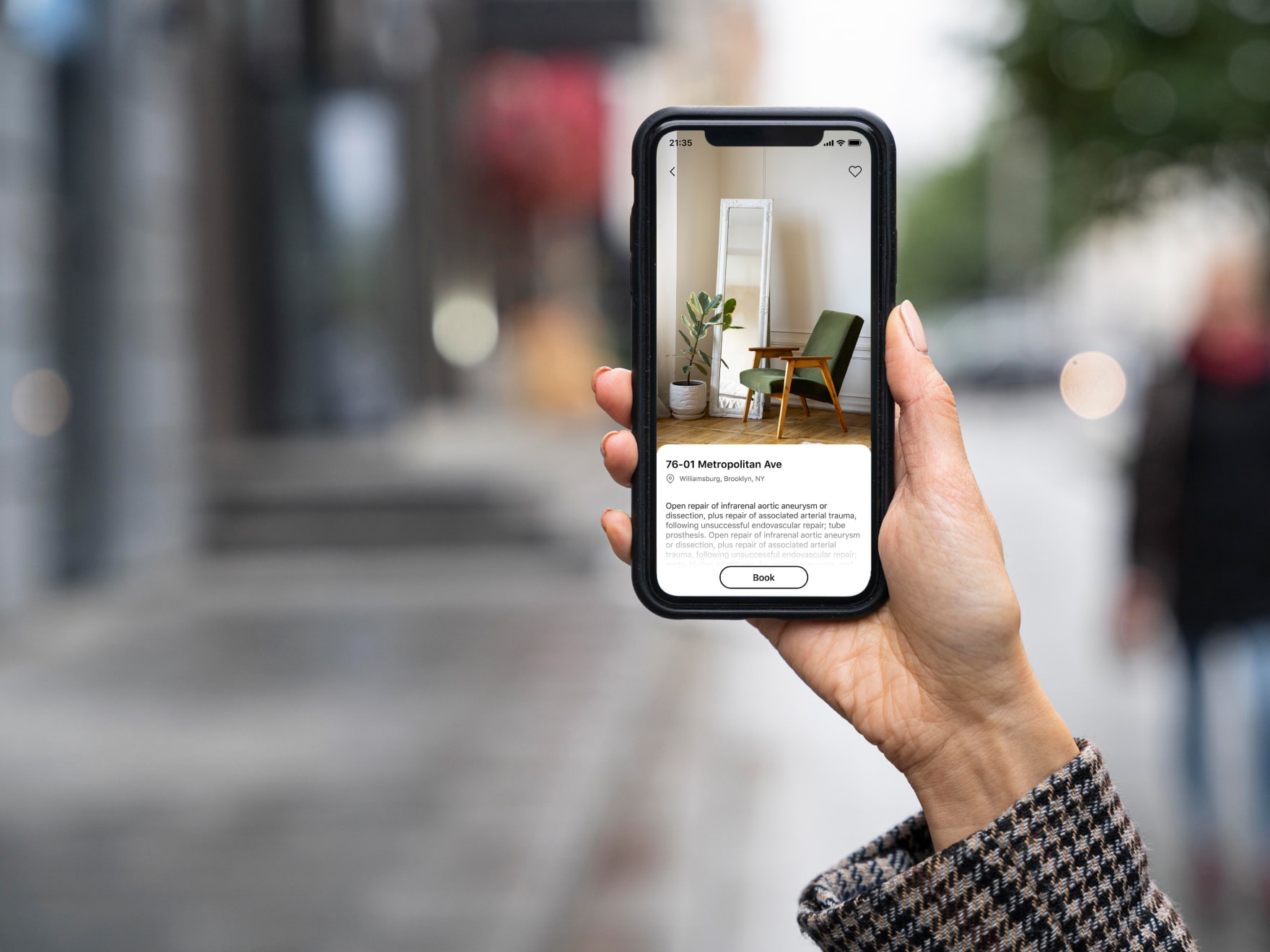
Meldingen din er sendt.
Vi behandler forespørselen din og kontakter deg så snart som mulig.

Ved å registrere deg godtar du vår Retningslinjer for personvern, inkludert bruk av informasjonskapsler og overføring av dine personopplysninger.